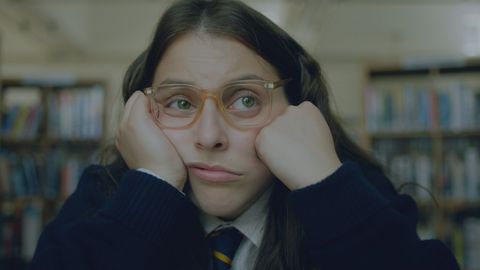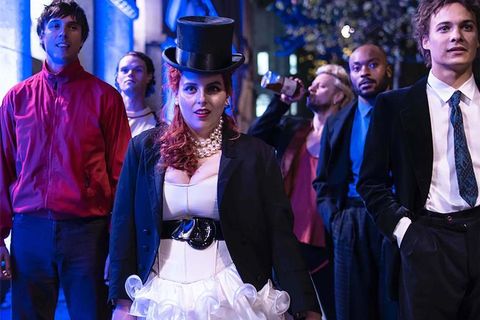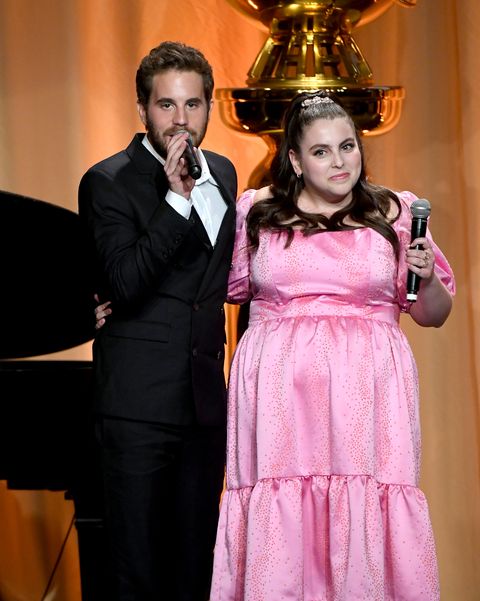Beanie Feldstein is a team player, known both for her part in two of the best film depictions of friendship in recent memory (Lady Bird and Booksmart) and her rock-solid bonds with longtime friends like Ben Platt and Molly Gordon. But in How to Build a Girl, Feldstein is, for the first time, the true lead in a production. The adaptation of Caitlin Moran’s semi-autobiographical 2014 novel focuses on the coming of age of Johanna Morrigan, a spirited and imaginative teenage girl in ‘90s Wolverhampton, England who begins supporting her family as a rock critic. Feldstein sees the role as a major professional step that felt in line with her personal trajectory.
“Caitlin is one of my feminist heroes and I think Johanna Morrigan is a girl that I one hundred thousand percent could have used when I was 14 or 15—or 26, honestly,” she says. “I’ve never seen a character like her at the center of her own movie and it was really meaningful and kind of life changing for me to play her.”
The remarkably kind and openhearted star spoke with ELLE.com from her family home about why social distancing is more important than any film, singing with Ben Platt for Stephen Sondheim, and the best audition she ever had.
So much of your work has been in wonderful ensemble films. Given that your How to Build a Girl character is truly a lead, how was that different than making something like Booksmart?
It was a brand-new experience. I feel like a student of filmmaking, so every new experience is like another way to learn. There were more scenes than I’ve ever done alone, and there were several days on the call sheet where it was just me or just me and the dog. It was my first time being on every page of a script, it was my first time using an accent in a film, and my first time living and working in England and being a part of a British cast. But at the heart of it, it was just telling an honest, funny, brave story of a girl trying to find herself, and that is my comfort zone. That feels very natural for me. So many of the other things were very scary and intimidating but I always came back to that core of, I know what we’re trying to tell.
Everybody is confronting this crisis in different ways, but having something so significant to you personally released in a different way than you expected, how do you manage your expectations?
My biggest priority right now is hoping the world heals and stays safe. We all have to do our part to keep everyone safe. I’ve been social distancing and self-isolating for two months—that’s the only way I can positively contribute, in addition to donating to incredible organizations and fundraising and things like that. I’m so grateful for the essential workers who put their lives on the line every day—delivery people and postal workers and [those in] the medical field. There are so many people that have a much harder situation than I do, so I’m trying to feel grateful every day I wake up healthy and able to talk to all these people on the phone or on Zoom about How to Build a Girl.
And also, on a bit of a lighter note, I feel so grateful for all the incredible content that has been coming out over the past two months. Genuinely! Ozark and Little Fires Everywhere and Bad Education on HBO. There are so many films and television shows I look forward to. The joy of knowing that at the end of the day I have something incredible to watch has been such a gift. That’s what I keep coming back to. How to Build a Girl is such a joyful exploration and it’s a really compassionate movie. We can all use a little bit of Johanna Morrigan’s love of the world and her effervescent spirit. Even before this situation, we filmed the movie almost two years ago. I needed it then, and I need it even more now.
Did you get to spend any time with Caitlin Moran making the film?
I got to meet Caitlin at my audition, which is pretty nutty looking back. I remember being like, why are they introducing to me to Caitlin? Clearly I did not understand, but they must have already made their decision. The audition process was really remarkable. Firs, I Skyped with the creative team, the producer, and the director—without Caitlin—to just talk about the film. They were deciding if they were open to looking to people who weren’t British for the role. Then they flew me to London to do a formal test audition. Usually a test is very frightening: You stand in front of twenty people in a room and it’s multiple hours. It’s very intimidating and scary and a lot of pressure.
I got there and the night before the audition they were like, ‘We’d love to take you out to dinner’ and I was like, ‘that’s incredibly kind and amazing.’ Then the actual audition was over two days. Coky [Giedroyc], the director, and I just walked around different areas of London, and she showed me parts of the city that are most similar to [what] they were in the ‘90s—so what Johanna would have seen.
At the end of those two days they were like, we’re taking you to dinner with Caitlin now that you’re done. We had four members of the creative team—all female by the way—and they took me to a six-hour dinner with Caitlin. It was one of the best evenings of my entire life. When I left they put me in a black London cab and I called my mom on the way home and I was like I don’t know if I’ll get the role but this was one of the most extraordinary evenings I’ve ever had. Even if it ended at that, I felt very lucky to have had that experience.
How did you master the very specific accent you use in the film?
I felt a massive responsibility because I came to cherish Wolverhampton and the people I got to know there. I went for three weeks before we started shooting and I worked in a store in the town square, just off the High Street. Per the instructions of our director, I had to speak in the accent from the moment I began my shift to the moment I ended it, whether that was talking to customers or ordering lunch on my break. It was completely surreal and utterly wonderful and also imperative to the process.
I cannot imagine doing How to Build a Girl without the gift of time to prepare. To go to Wolverhampton and work there and set up a whole community there—I still check in on the women I worked with in the store and I’m on their Facebook group. I felt such a responsibility to get it right, because it’s not an area of England that is often portrayed in the media. I wanted it to shine in all the glory it deserves.
You did a virtual performance to celebrate Stephen Sondheim’s 90th birthday. What was it like to connect with so many people remotely?
I feel so grateful to the incredible masterminds that are putting together these cathartic virtual experiences. I’ve been a part of a few of them now, and both the seder and the Sondheim celebration were beautifully collaborated and curated. I so enjoyed watching them as a spectator. I was going in only aware of what I had contributed and I was in awe of both. Particularly for Sondheim, he’s my hero, so the idea of getting to sing for his birthday, to raise money for a beautiful organization, that he would see it—it was surreal.
If I’m being honest, I’ve sung my whole life and I love to sing, but it gives me anxiety because I don’t feel like I’m as skilled in it as so many of the people I love. I was like, you got this, Bean! I had to talk myself up. It’s my little area of insecurity that I have to work on. I loved doing it because Into the Woods is my favorite musical and Ben is my best friend and we cherish that song and all of his music—it taught me how to feel. I’m in my childhood home right now and if I could’ve told my 10-year-old self that I would be on a list like that for a Sondheim celebration, it wouldn’t have been believable to me at all. At 26, it’s still not believable.




